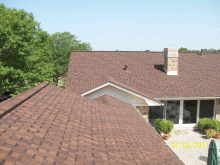 When designing sustainable homes and commercial buildings, having an area that is energy and cost efficient with good indoor air quality and controlled moisture must also be sound-proof for a totally comfortable environment. One of the critical elements in high performance residential and commercial building construction is featuring the principle of thermal and moisture protection.
When designing sustainable homes and commercial buildings, having an area that is energy and cost efficient with good indoor air quality and controlled moisture must also be sound-proof for a totally comfortable environment. One of the critical elements in high performance residential and commercial building construction is featuring the principle of thermal and moisture protection.
Another important element is to incorporate the principle of sound. Manufacturers are continuously developing acoustic and sound-absorbing products that can be applied to a roof to eradicate noise issues and reduce its transmission into any living areas.
Following is some essential information regarding the transmission of noise and how to control it.
Transmittal Methods
Noise that comes from a roof can be a huge problem, interrupting the peaceful atmosphere inside interior living space. These sounds may originate from falling rain, hail, loud neighbors, or even foot traffic. Keeping this in mind, sound is produced and transferred by three different methods.
- Airborne – Waves of pressure are transmitted through the air and can cause vibrations from one part of a structure to adjacent structures.
- Impact or Structure-Borne – Mechanical waves are transmitted from an impact of the structure to underside assemblies. A common example is noise produced by footsteps from walking on the roof.
- Flanking Transmission – This is the transmittal of mechanically-produced sounds from a certain structure, such as roofing materials bumping into another element like metal frames.
Control Methods
Unwanted noise disturbances can have a strong impact on the comfort of occupants if the levels rise to dangerous high decibels for a prolonged period of time. This problem can be controlled through absorption, blocking, breaking up the path of the sound waves, or isolating the noise. Control is obtained by focusing on reducing the audible waves produced by the source. Noise barriers can be built with acoustical gypsum and heavy roofing materials. Carpet or draperies can be installed to the building interior and sound-proof material can be used on the exterior as well.
Underlying Methods
Metal roofs can generate approximately seventy decibels of sound from rainfall alone. If the metal is not properly secured and installed, it can increase audible sound levels inside the living spaces. Prevent this by accurately fastening metal roofing and placing it over entangled filament underlayment to reduce noise by 21.5 decibels. In addition, when metal roofing is installed over purlins without sheathing, noticeable sound can be generated; however, when installed over heavy substrate with normal insulation, noise production is significantly reduced.
Controlling noise inside a building is a complex process. Ongoing technology is being developed but is rarely used and put into practice. There is no need to experience the troublesome, stressful, and unhealthy byproduct of unwanted noise; it can be eliminated by installing innovative and sustainable products that are a practical and economical solution to address the issue. Noise level improvement can be attained by understanding important information about roof noise transmission and then controlling it from this standpoint!
Call Schulte Roofing and Find the Best Roof Houston Experts!
Are you trying to find an excellent roof Houston company? Greater Houston area customers can call Schulte Roofing at 800-367-7663 to handle all of your roofing needs!
